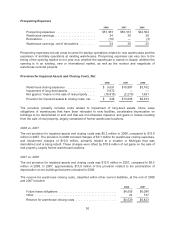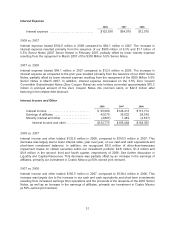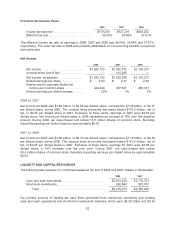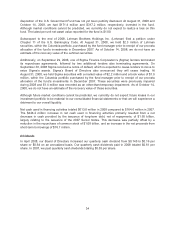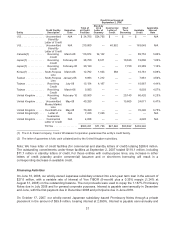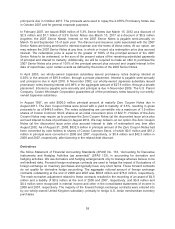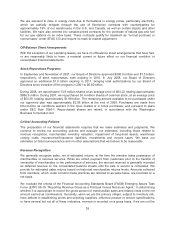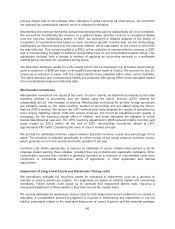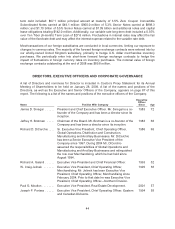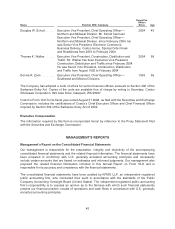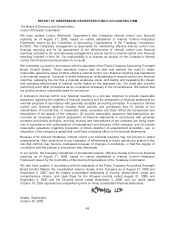Costco 2008 Annual Report Download - page 41
Download and view the complete annual report
Please find page 41 of the 2008 Costco annual report below. You can navigate through the pages in the report by either clicking on the pages listed below, or by using the keyword search tool below to find specific information within the annual report.We are exposed to risks in energy costs due to fluctuations in energy prices, particularly electricity,
which we partially mitigate through the use of fixed-price contracts with counterparties for
approximately 19% of our warehouses in the U.S. and Canada, as well as certain depots and other
facilities. We have also entered into variable-priced contracts for the purchase of natural gas and fuel
for our gas stations on an index basis. These contracts qualify for treatment as “normal purchase or
normal sales” under SFAS 133 and require no mark-to-market adjustment.
Off-Balance Sheet Arrangements
With the exception of our operating leases, we have no off-balance sheet arrangements that have had,
or are reasonably likely to have, a material current or future effect on our financial condition or
consolidated financial statements.
Stock Repurchase Programs
In September and November of 2007, our Board of Directors approved $300.0 million and $1.0 billion,
respectively, of stock repurchases, both expiring in 2010. In July 2008, our Board of Directors
approved an additional $1.0 billion expiring in 2011, bringing total authorizations by our Board of
Directors since inception of the program in 2001 to $6.80 billion.
During 2008, we repurchased 13.8 million shares at an average price of $64.22 totaling approximately
$886.9 million. During 2007, we repurchased 36.4 million shares of common stock, at an average price
of $54.39, totaling approximately $1.98 billion. The remaining amount available to be purchased under
our approved plan was approximately $2.06 billion at the end of 2008. Purchases are made from
time-to-time as conditions warrant in the open market or in block purchases, and pursuant to plans
under SEC Rule 10b5-1. Repurchased shares are retired, in accordance with the Washington
Business Corporation Act.
Critical Accounting Policies
The preparation of our financial statements requires that we make estimates and judgments. We
continue to review our accounting policies and evaluate our estimates, including those related to
revenue recognition, merchandise inventory valuation, impairment of long-lived assets, warehouse
closing costs, insurance/self-insurance liabilities, investments and income taxes. We base our
estimates on historical experience and on other assumptions that we believe to be reasonable.
Revenue Recognition
We generally recognize sales, net of estimated returns, at the time the member takes possession of
merchandise or receives services. When we collect payment from customers prior to the transfer of
ownership of merchandise or the performance of services, the amount received is generally recorded
as deferred revenue on the consolidated balance sheets until the sale or service is completed. We
provide for estimated sales returns based on historical merchandise returns levels. Amounts collected
from members, which under common trade practices are referred to as sales taxes, are recorded on a
net basis.
We evaluate the criteria of the Financial Accounting Standards Board (FASB) Emerging Issues Task
Force (EITF) 99-19, “Reporting Revenue Gross as a Principal Versus Net as an Agent,” in determining
whether it is appropriate to record the gross amount of merchandise sales and related costs or the net
amount earned as commissions. Generally, when we are the primary obligor, subject to inventory risk,
have latitude in establishing prices and selecting suppliers, influence product or service specifications,
or have several but not all of these indicators, revenue is recorded on a gross basis. If we are not the
39



